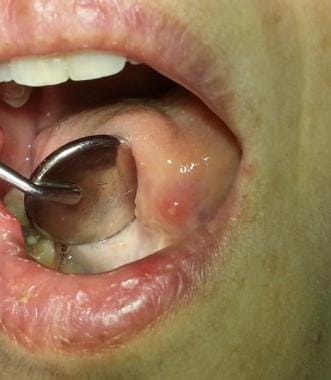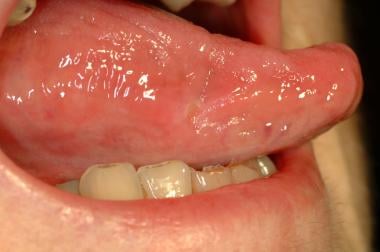Practice Essentials
Recurrent aphthous stomatitis (RAS) is a common ulcerative inflammatory condition of the oral cavity; it typically starts in childhood or adolescence as small recurrent, painful, round or ovoid ulcers with well-defined erythematous margins, like a halo, and a central yellow or gray floor.
See the images below.
 Recurrent aphthous ulcer with well-defined erythematous halo and central yellowish gray base, on left anterolateral tongue.
Recurrent aphthous ulcer with well-defined erythematous halo and central yellowish gray base, on left anterolateral tongue.
A positive family history of RAS is common, and the natural history typically involves resolution in the third decade of life. Not all recurring ulcers represent RAS, however, so the clinician must distinguish localized RAS from lesions arising from an underlying systemic disorder. Proposed causative factors for RAS include nutritional deficiency, immunologic factors, psychological stress, [1] and dietary allergies, as well as trauma in patients with genetic susceptibility to RAS. [2] . Ulcers with similar clinical features but rarely resolving spontaneously with age may be associated with systemic conditions such as Behçet syndrome, auto-inflammatory syndromes, gastrointestinal disease, or immune defects such as HIV/AIDS. [3]
Symptoms and symptoms of recurrent aphthous stomatitis (RAS)
For 2-48 hours before an ulcer develops, RAS is characterized by a prodromal burning sensation. [2] Ulcers commonly present on lining oral mucosa, such as buccal and labial mucosa, and on the tongue, rather than on attached oral mucosa.
Diagnosis and management of recurrent aphthous stomatitis (RAS)
Diagnosis of RAS is based on history and clinical features. Topical corticosteroids (TCs) remain the mainstays of treatment. If RAS fails to respond to local measures, systemic immunomodulators may be required. A wide spectrum of agents has been suggested as beneficial, but few studies have been performed to assess the efficacy of these drugs (or their adverse effects are significant).
Key points
Key points include the following:
-
RAS is the most common ulcerative condition of mouth
-
The clinician must distinguish localized RAS from ulcers resulting from an underlying cause
-
Topical and systemic therapies are used to manage RAS
Pathophysiology
The etiology of RAS is still unknown; the condition may in fact manifest from a group of disorders of quite different etiologies rather than from a single entity. [4]
Despite many studies trying to identify a causal microorganism, RAS does not appear to be infectious, contagious, or sexually transmitted. Immune mechanisms appear to be at play in persons with a genetic predisposition to oral ulceration.
A genetic basis exists for some RAS. This is shown by a positive family history in about one-third of patients with RAS; an increased frequency of human leukocyte antigen (HLA) types A2, A11, B12, and DR2; and susceptibility to RAS, which segregates in families in association with HLA haplotypes. RAS probably involves cell-mediated mechanisms, but the precise immunopathogenesis remains unclear. Phagocytic and cytotoxic T cells probably aid in destruction of oral epithelium that is directed and sustained by local cytokine release.
Patients with active RAS have an increased proportion of gamma-delta T cells compared with control subjects and patients with inactive RAS. Gamma-delta T cells may be involved in antibody-dependent cell mediated cytotoxicity (ADCC). Compared with control subjects, individuals with RAS have raised serum levels of cytokines such as interleukin (IL)–6 and IL-2R, soluble intercellular adhesion modules (ICAM), vascular cell adhesion modules (VCAM), and E-selectin; however, some of these do not correlate with disease activity.
Cross-reactivity between a streptococcal 60- to 65-kd heat shock protein (hsp) and the oral mucosa has been demonstrated, and significantly elevated levels of serum antibodies to hsp are found in patients with RAS. Lymphocytes of patients with RAS have reactivity to a peptide of Mycobacterium tuberculosis. Some cross-reactivity exists between the 65-kd hsp and the 60-kd human mitochondrial hsp. Monoclonal antibodies to part of the 65-kd hsp of M tuberculosis react with Streptococcus sanguis. RAS thus may be a T cell–mediated response to antigens of S sanguis, which cross-react with the mitochondrial hsp and induce oral mucosal damage. RAS patients have an anomalous activity of the toll-like receptor TLR2 pathway that probably influences the stimulation of an abnormal Th1 immune response.
Predisposing factors may include any of the following:
-
Stress - This underlies RAS in some cases; ulcers appear to exacerbate during school or university examination times.
-
Trauma - Biting of the mucosa and wearing of dental appliances may lead to some ulcers; RAS is uncommon on keratinized mucosae.
-
Endocrine factors in some women - RAS is clearly related to the progestogen level fall in the luteal phase of the menstrual cycle, and ulcers may then temporarily regress in pregnancy.
-
Cessation of smoking - This may precipitate or exacerbate RAS in some cases.
-
Allergies to food - Food allergies occasionally underlie RAS; the prevalence of atopy is high. Patients with aphthae may occasionally have a reaction to cow's milk and may have been weaned at an early age.
Aphthous-like ulcers may be seen in the following:
-
Hematinic deficiency: Up to 20% of patients are deficient of iron, folic acid (folate), or vitamin B.
-
Malabsorption in gastrointestinal disorders: About 3% of patients experience these disorders, particularly celiac disease (gluten-sensitive enteropathy) but, occasionally, Crohn disease, pernicious anemia, and dermatitis herpetiformis. HLA DRW10 and DQW1 may predispose patients with celiac disease to oral ulceration.
-
Immune deficiencies: Ulcers (aphthous-like ulcers) may be seen in patients with HIV, neutropenias, and some other immune defects.
-
Drugs, especially NSAIDs, alendronate, and nicorandil [5] : These may produce mouth ulcers, but the history should distinguish them from RAS.
-
Sodium lauryl sulfate (SLS): This is a detergent in some oral healthcare products that may aggravate or produce oral ulceration.
A study by Gülseren et al suggested that food additives may be involved in the etiology of RAS. In the study, patch testing was used to test for reactions to 23 food additives in 24 patients with RAS and 22 controls. The study found that 21 (87.5%) of the patients with RAS demonstrated positive patch test reactions to one or more allergens, compared with 3 (13.6%) of the controls, with the additives producing the most positive reactions in the RAS patients being cochineal red (15 patients; 62.5%), azorubine (11 patients; 45.8%), and amaranth (6 patients; 25%). [6]
A study by Zhang et al indicated that impairment of the enzymatic antioxidant defense system may be key to the pathogenesis of RAS in patients with the condition who have active lesions. The investigators found significantly lower serum levels of superoxide dismutase, catalase, and glutathione peroxidase in active lesion RAS patients than in patients in the remission stage of RAS or in healthy controls. Serum levels did not significantly differ between the remission patients and controls. [7]
Epidemiology
Frequency
United States
RAS affects 5-66% of the population. Approximately 1% of children from higher socioeconomic groups in developed countries have RAS; however, 40% of selected groups of children can have a history of RAS, with ulceration beginning before age 5 years and with the frequency of affected patients increasing with age. Multiple factors such as the specific population evaluated, diagnostic criteria, and environmental factors, affect the prevalence of RAS. [2]
Mortality/Morbidity
Most patients with RAS are otherwise healthy. However, a study by Wiriyakijja et al of 120 patients with RAS indicated that the condition is associated with psychological distress. Using the Hospital Anxiety and Depression Scale (HADS) and the 10-item Perceived Stress Scale (PSS-10), the investigators reported the prevalence of anxiety, depression, distress, and moderate-to-high perceived stress in the cohort to be 42.5%, 18.33%, 28.33%, and 71.67%, respectively. The study found the psychological symptoms to be linked to ethnicity, alcohol consumption, disease comorbidities, clinical type of RAS, ulcer size, pain, and RAS disease activity. [8]
Race
RAS has been reported in all races
Sex
A slight female predominance exists.
Age
RAS normally first arises in childhood or adolescence, predominantly between the ages of 10 and 19 years, with the frequency decreasing in subsequent years. The chance of children with RAS-positive parents presenting with RAS is high, up to 90%, while the chance of presentation in children with RAS-negative parents is just 20%. It is interesting to note that the prevalence of presentation has been found to be five times greater in children with high socioeconomic status. [2]
Prognosis
Minor aphthous ulcers (MiAUs) are usually self-limiting, with the usual duration being about 10-14 days without any active treatment. Major aphthous ulcers (MjAUs) can last up to about a month. A third type of RAS, the herpetiform ulcers, are devastating, lasting from 10 days to about 100 days. Ulcers respond well to topical medications, although sometimes a systemic medication may be necessary.
Patient Education
Patient education regarding this condition may facilitate early treatment during prodromal phases to minimize the discomfort. Children with extensive ulcers should receive proper diet and hydration, as they may avoid food intake as well as hydration. When using palliative measures such as topical numbing medication, the patient must be cautioned against trauma to anesthetized areas while eating or sleeping. The patient should avoid precipitating factors, such as allergens, trauma, and other potential triggers.
For patient education resources, see the Oral Health Center, as well as Canker Sores.
-
Traumatic ulcer on ventrum/lateral margin of tongue; these must be differentiated from aphthae.
-
Recurrent aphthae in floor of mouth, showing ovoid ulcer with inflammatory halo.
-
Typical aphthous ulcer in a common site, showing inflammatory halo surrounding a yellowish round ulcer.
-
Recurrent aphthous ulcer with well-defined erythematous halo and central yellowish gray base, on left anterolateral tongue.
-
Recurrent aphthous stomatitis with ulcers of varying sizes - large ulcers on the right buccal mucosa and a small ulcer on the anterior tongue.






